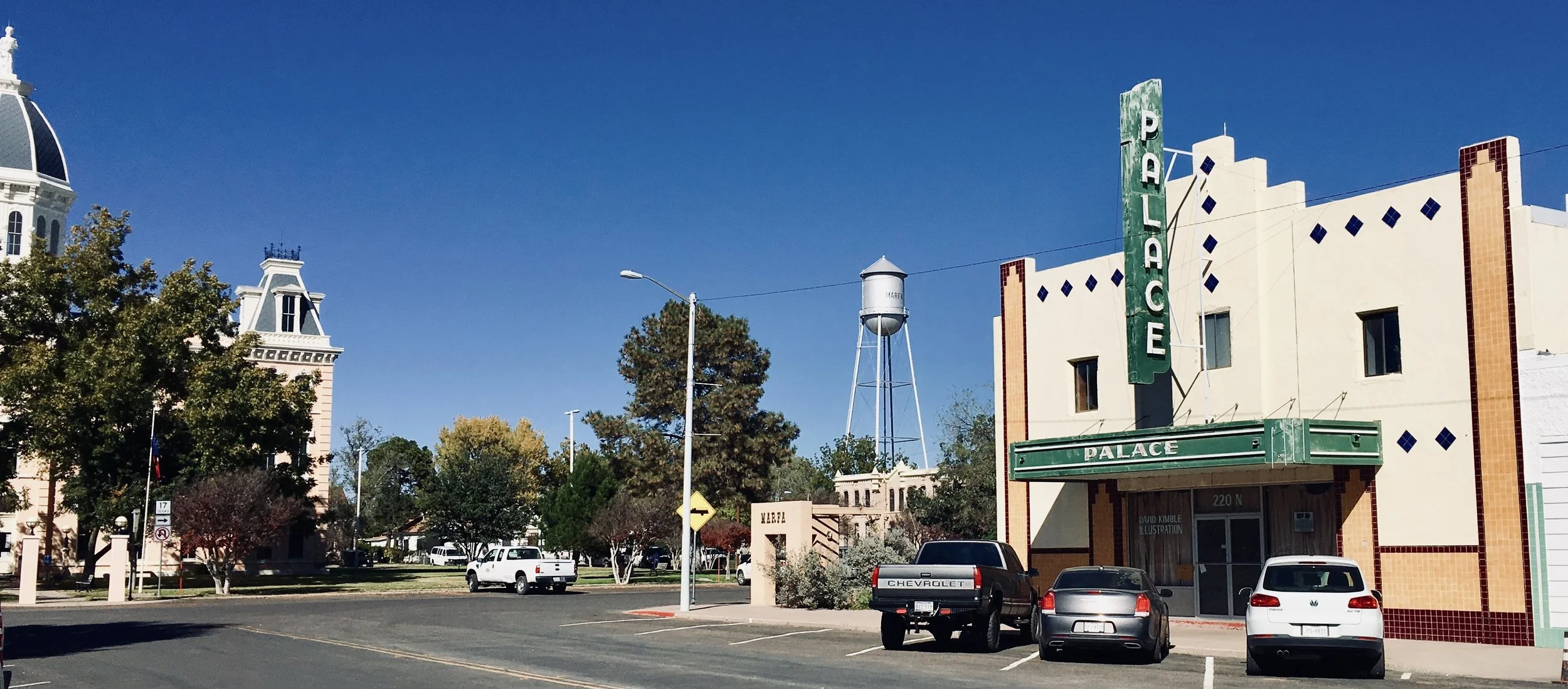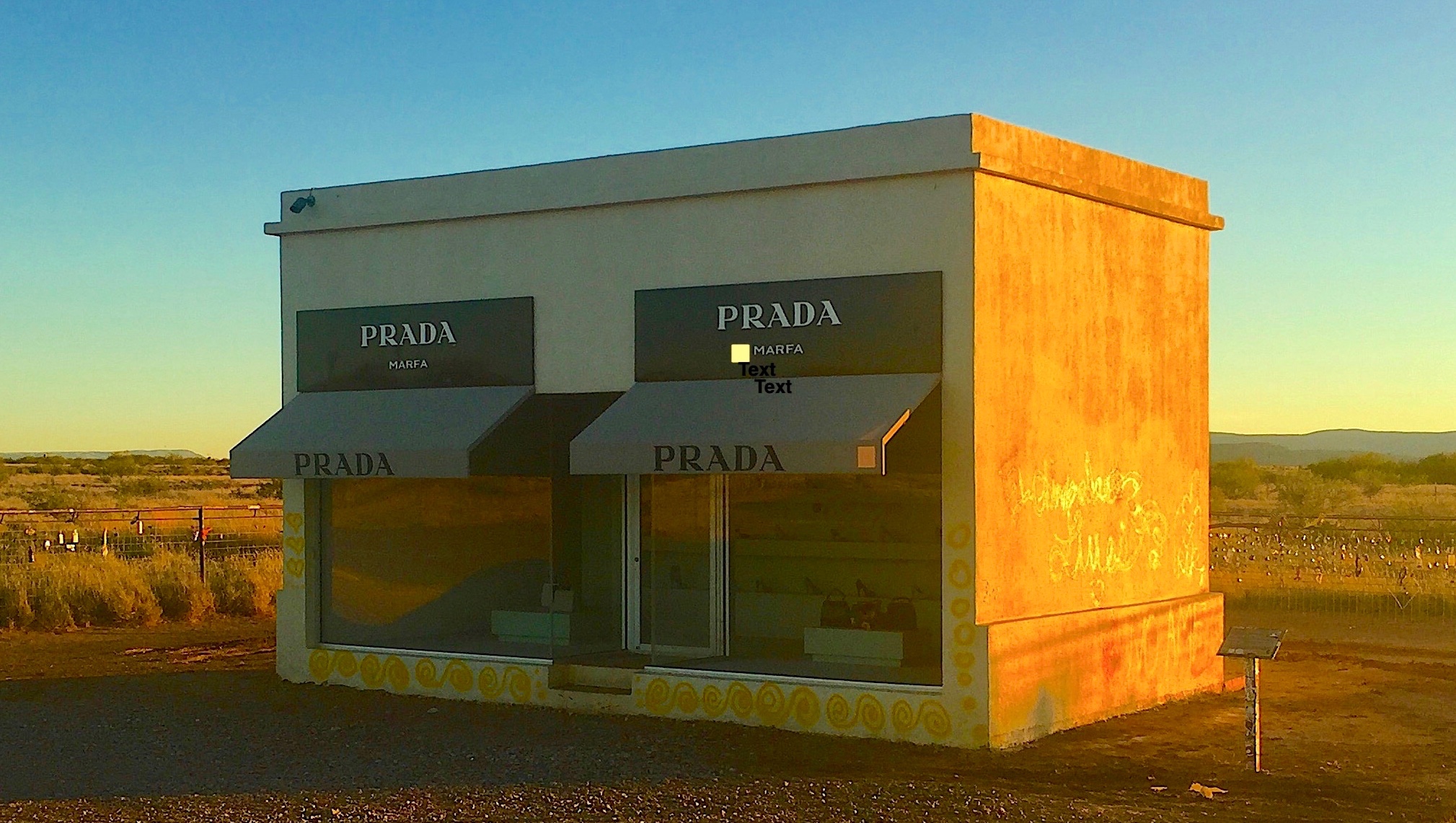Marfa
Look up “middle of nowhere” and you might just find a photo of Marfa. Is this strange spot in far west Texas, at least three and a half hours’ drive from any airport, worth the considerable effort to find it? The short answer is absolutely.
My wife and I scratched Marfa off our bucket list this fall by flying into El Paso and driving nearly a thousand miles eastward to also explore the Texas Hill Country and enjoy the modern attractions of Austin for a few days before returning home. It’s an adventure we can heartily recommend.
Marfa is a hard-scrabble town of less than two thousand hardy souls, not counting the few hundred determined tourists who may be there at any given time. This is high desert. At nearly 5000 feet—expect hot days and cold nights—Marfa comes with both altitude and attitude. It may well have become just another West Texas ghost town but for the New York artist Donald Judd. He recalled the eerie emptiness and haunting beauty of the land he had observed from the window of a cross-country bus ride to Los Angeles as a young soldier about to be deployed to Korea in the fifties. Judd’s increasingly large-scale sculptural works—as well as his ambitions—had outgrown his studio and living space in SOHO, so he returned to the Big Bend area of Texas in search of a place big enough for his monumental work and dreams. The Judd legacy alone is justification enough to make the journey to experience Marfa.
Once there, one of the paradoxical charms of Marfa is its compactness and accessibility. The works of Judd and those of the other notable artists who followed him there—John Chamberlain, Robert Irwin and Donald Flavin, among others—are all within a few minutes’ drive if not a short walk. Unless you should choose to experience the quirky digs at El Cosmico —essentially an array of tents, tepees, yurts and trailers strewn across a barren field less than a mile south of “downtown” Marfa—all of the few shops, bars and restaurants are within easy walking distance of the more conventional lodgings in town.
Hotel options in Marfa range from the historic Paisano (recall Rock Hudson and Elizabeth Taylor in the movie Giant) to the oh-so-trendy Saint George (our wise choice). These two don’t just define the range of recommended hotel options in Marfa, they make up the entire list. Both are more than acceptable, and each will provide earplugs for the light sleepers who may be awakened by the long, jarring blasts of the horns of the freight trains that speed through the town at random times throughout the night. We encountered no such problems ourselves.
A very notable exception to the compactness of the town is the Prada store, a work of art that appears jarringly and incongruously on an otherwise empty stretch of Highway 90 about 35 miles west of Marfa. You will pass it on your right driving from El Paso. If you come to Marfa via a different route, it is worth the hour’s drive there and back just to see and take the obligatory photos of this retail apparition. Despite the authenticity of the products displayed inside its windows, this is pure art, not retail. The work was installed in 2004 by a pair of German-based artists, Michael Elmgreen and Ingar Dragset. There have been several incidents of vandalism at the site over the years, but the only scar we observed was graffiti scrawled on the side of the structure. Since the artists intended that the work become a part of its environment and thus endure the ravages of weather and time, it must also deal with acts, however senseless, of the humans who interact with it.
Although it is often said that no one comes to Marfa for the food, there is more than enough in both quality and diversity to sustain visitors who are not likely to stay more than a few days. During our visit we enjoyed nice dinners at the Capri and at Stellina. Cochineal was widely recommended to us but was not open while we were there. In fact, many places in Marfa are open only Thursday to Sunday, so plan accordingly. Taking lunch at Marfa Burrito is like being invited into the home of a hospitable Mexican woman who prepares your meal by hand. In fact, that’s quite literally what it is. The Lost Horse Saloon (look for the sign that says only “BEER”) is a quintessential dive bar, where local color can be observed while drinking a long-neck Lone Star. You might just have a conversation with the one-eyed cowboy owner, who was one of the original Marlboro men.
But it is true that you will not visit Marfa for the food and drink. Art’s the thing here. A great starting point is the Donald Judd Foundation whose headquarters sits on a corner in the middle of the town. I would highly recommend taking one of the guided tours the foundation offers of Judd’s former residence and studios a few blocks away. Judd was keenly interested in saving and re-purposing existing structure. The complex he created is on the site of an abandoned military facility. All the art seen here is early work of Judd’s except for the few works gifted to him by other artists with whom he was close.
Judd named this property La Mansana de Chinati by Judd, but it is known locally as the Block. A tour led by an engaging docent provided invaluable insights into Judd’s esthetic and the unusual way in which he integrated his work as an artist with his daily family life. We were particularly struck by the sheer scale and the wide diversity of his library, which revealed his interests in history, Asian cultures, architecture and so much more.
The Chinati Foundation is a separate, complementary organization created by Judd. It is housed at the site of a much larger, now-abandoned military base about a mile south where many of the buildings are now used as exhibition space for the work of Judd and others. A large open field there was chosen by Judd as the site of his largest (and nameless) installation, a one-kilometer-long linear array of huge, symmetrical concrete structures arranged in fifteen separate configurations. The Chinati Foundation offers free access to these concrete works and both guided and self-guided tours of Judd’s aluminum works and those of other artists who have come to create there.
An effective antidote to Marfa art overload is to get the heck out of town. Alpine and Marathon are both worthwhile excursions, located 30 and 60 minutes respectively east on Highway 90. In addition, Fort Davis is only a 20-minute drive north and offers an attractive state park with nice hiking trails and excellent views across the Chihuahuan Desert. You can also visit the McDonald Observatory nearby. Driving in far west Texas was a treat unto itself for an Easterner used to constant traffic. The two-lane country roads are in great condition and nearly empty, with a posted speed limit of 75mph.
Another quirky local attraction that gets mixed reviews is the so-called Marfa lights. Taking this in requires a ten-minute night-time drive east in the hope of seeing bright lights of an apparently unexplained origin that may or may not appear in the distance. We decided to pass on this, just as we had on spending a day sitting beside Loch Ness, hoping to spot the monster while visiting the Scottish Highlands.
While we never encountered a single Texas Ranger on our trip, we did have frequent sightings of the omnipresent US Border Patrol. Marfa sits only sixty miles from the Rio Grande and our southern neighbor. When we were stopped at a mandatory immigration check point on I-10 outside El Paso, the agent asked if we were US citizens. I suppressed the temptation to answer “Si,” and at our “Yes” he simply said, “Have a good day.” We also ran into numerous groups of Border Patrol agents hanging out at the Dairy Queen and at service stations we passed.
The border town of Presidio is less than an hour south of Marfa, and from there you can cross the river into the picturesque Mexican town of Ojinaga. If you can add a couple of days more to your visit, you should explore the enormous and too-often overlooked Big Bend National Park a few hours’ drive south. We will definitely add that to our next visit.
An excellent introduction to the area of far west Texas is the next-to-last episode of Anthony Bourdain’s CNN series Parts Unknown which was filmed just a few months before his untimely death in Paris. A vivid, unvarnished view of Marfa can be seen in the very adult series, I Love Dick. The show’s eight episodes are available on Amazon Prime Video.
So, yes, by all means, book yourself a ticket to El Paso or Midland. Check in advance to see if there are any events scheduled at the Marfa Ballroom. Plan on spending two or three nights. Get the best deal you can on a rental car, tune the dial to KRTS 93.5 FM, Marfa Public Radio, and head toward Marfa. You will be well-rewarded for all your effort.




